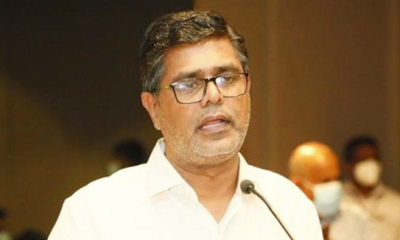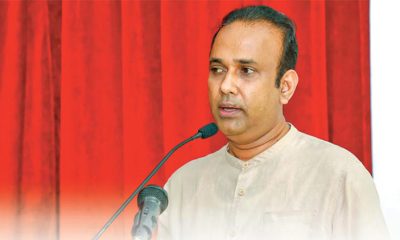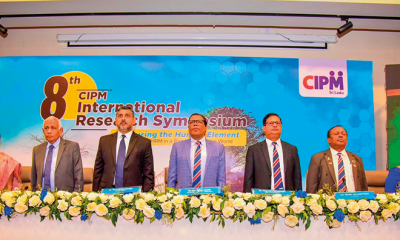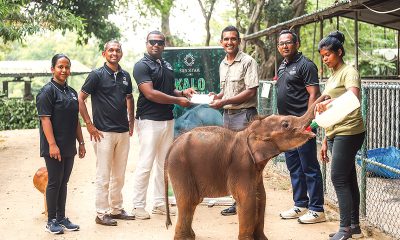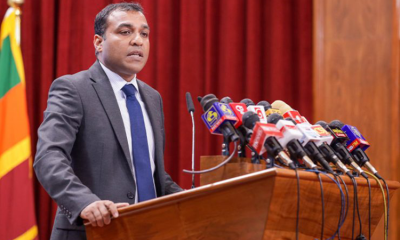Features
What is this vaccine against covid-19?

By Dr. Kavindya Marapana
 COVID-19 has impacted millions of lives worldwide. Sri Lanka reported its first case of COVID-19 on 27thJanuary 2020 and since then the epidemic has affected Sri Lanka significantly, especially since the second wave of COVID-19 in October 2020, causing a severe health, economic and social burden. Globally, whilst many people may have asymptomatic infection, around 40% of the infected persons develop a range of mild symptoms which include fever, a new and continuous cough, shortness of breath, sore throat, fatigue, loss of appetite, diarrhoea, etc. Only around 15% of the patients develop severe complications such as pneumonia, and out them around 5% suffer from life-threatening diseases including severe respiratory distress syndrome, thromboembolic events and multi-organ failure. In Sri Lanka, 79, 999 cases have been identified to the date of writing and although the incidence of COVID-19 related complications seem to be low, 445 deaths have been reported up-to-date, including paediatric deaths. COVID -19 is also believed to have long-term effects on neurological system which is still in research stage.
COVID-19 has impacted millions of lives worldwide. Sri Lanka reported its first case of COVID-19 on 27thJanuary 2020 and since then the epidemic has affected Sri Lanka significantly, especially since the second wave of COVID-19 in October 2020, causing a severe health, economic and social burden. Globally, whilst many people may have asymptomatic infection, around 40% of the infected persons develop a range of mild symptoms which include fever, a new and continuous cough, shortness of breath, sore throat, fatigue, loss of appetite, diarrhoea, etc. Only around 15% of the patients develop severe complications such as pneumonia, and out them around 5% suffer from life-threatening diseases including severe respiratory distress syndrome, thromboembolic events and multi-organ failure. In Sri Lanka, 79, 999 cases have been identified to the date of writing and although the incidence of COVID-19 related complications seem to be low, 445 deaths have been reported up-to-date, including paediatric deaths. COVID -19 is also believed to have long-term effects on neurological system which is still in research stage.
The Ministry of Health has introduced a Covid-19 vaccine, which is considered safe and efficacious as evident from the available information about vaccine trials. Given the high priority requirement of safeguarding essential healthcare facilities of the country, adhering to global Covid-19 vaccination prioritization guidelines and recommendations by the National Advisory Committee of Communicable Diseases, healthcare staff and other support frontline workers have been inoculated.
Over 280 different COVID-19 vaccines are at various stages of development. Some have been made with the help of currently available vaccine technology, and completely new approaches have been adopted in producing others. While it normally takes several years to develop a vaccine, scientists across the world have worked collaboratively and expeditiously to achieve the same amount of work in a few months to make a safe and effective vaccine available as soon as possible. Although clinical trials have been carried out more rapidly than they have for other vaccines, this has been achieved by conducting some of the steps in parallel rather than sequentially and vaccine safety has not been compromised.
With the initiation of the vaccination programme in Sri Lanka, lot of questions have been raised by the public and we believe to answer a few common questions that have been raised frequently with the expertise of Dr. Chintha Karunasekara, Consultant Microbiologist at Lady Ridgeway Hospital for Children.
What is the vaccine given to
the Sri Lankans at the moment?
It is the COVISHIELD vaccine made by the Serum Institute of India (SII) that is brought down to Sri Lanka as the first batch of vaccines against corona virus. It is the same vaccine as the COVID-19 Vaccine AstraZeneca (ChAdOx1nCoV-19 Corona Virus Vaccine-Recombinant) developed by the University of Oxford but is developed to be effective at the temperatures of South Asian countries.
How does it protect me against COVID-19?
It is a viral vector vaccine, which uses a safe, weakened virus (adenovirus) which does not have the ability to multiply inside the body. It is genetically engineered to include a protein of SARS-C0V-2 (SARS-Cov-2 spike S) which triggers an immune response in the body against the COVID-19 virus, which protects the body from the possibility of developing disease or severe disease leading to death. The virus in the vaccine is destroyed after introducing the protein in the body. After the first dose of vaccine, the second dose is recommended to be taken in four weeks time. But the latest studies are recommending to increase the gap between the two doses up to 12 weeks for increased efficacy. The duration of protection by the vaccine is still not confirmed and is currently being studied. Therefore, with the current data it may require for it to be repeated yearly.
Is it safe for me to take it?
The COVID-19 vaccine AstraZeneca is currently under phase 3 vaccine trials and is found to be the most safe and efficacious vaccine among the vaccines currently being used. But there are instances where the vaccination should be strictly avoided and informed to the vaccination team without hesitance;
Known allergic reactions to the constituents of the COVISHIELD vaccine (L-Histidine, L-Histidine hydrochloride monohydrate, Magnesium chloride hexahydrate, Polysorbate 80, Ethanol, Sucrose, Sodium chloride, Disodium edetatedihydrate (EDTA), Water for injection)
History of severe allergic reactions leading to hospital admission or anaphylaxis.
Pregnancy , lactation and in children less than 18 years (not enough evidence is still available for the safe use of the vaccine among these groups)
Special precautions are to be taken if you are having a disease affecting bleeding and coagulation.
There are special situations where the vaccination is to be postponed for 4 to 8 weeks, and those are;
If you have any symptoms suggestive of COVID-19.
If you are suffering from an acute illness and not fit for the vaccination.
If you are already diagnosed with COVID-19 and received anti-CoV 2 monoclonal antibodies or convalescent plasma as a treatment option.
Being under regular treatment for long term diseases is not a reason to avoid the vaccine. But those conditions must be communicated to the doctor prior to the vaccination.
Why should I take it? Can I still be protected against COVID-19 without the vaccine?
Vaccination is one of the powerful public health interventions to combat this pandemic. Two key reasons to take the vaccine are to protect ourselves and to protect those around us. After vaccination most are protected from disease and severe disease. Vaccination curbs the spread of the virus by reducing the number of infections in a population.
The more people are immunized, the better the chances of reaching herd immunity. Herd immunity is even unvaccinated people in a population can be protected from a certain virus, like COVID-19, if a certain threshold of vaccination is reached in that population. Likewise, vaccines protect individuals, also protect communities.
Does it protect me for lifetime?
Once an individual is vaccinated, how long will their immunity to Covid-19 last? To answer this question more data from vaccine trials have been collecting and it depends on how a vaccine performs and how SARS-CoV-2 acts in the real world. For more longer immunity may need a booster vaccine.
Can I still transmit the disease to
those who are around me?
Vaccines are typically designed to prevent people from getting sick with the virus, but it is not yet clear if the COVID-19 vaccines can stop you from transmitting the virus to others. This is why is it important for people to continue taking precautions such as physical distancing, hand washing, wearing masks and avoiding gatherings, especially in poorly-ventilated spaces
But the most recent studies have shown the COVID-19 AstraZeneca vaccine to reduce the risk of transmission by 67%, which is a ray of hope that in the near future further developments would take place to further reduce the transmission.
The more people are immunized, the better the chances of reaching herd immunity.Herd immunity is when a population can be protected from a certain virus, like COVID-19, if a threshold of vaccination is reached
How bad can the side-effects be?
Around 75% of the healthcare personnel who received the vaccine reported to have mild to moderate symptoms as a result of the ongoing immune reaction following the vaccination. The most commonly reported symptoms were fever (low to high grade), chills, rigorus, muscle and joint pains, fatigue, lethargy, loss of appetite and vaccine site pain and swelling.
Less commonly abdominal pain, minor allergic reactions, enlarged lymph nodes have been reported but severe allergic reactions, anaphylaxis have not been reported so far in Sri Lanka.
The vaccination programme which is started by the government with the frontline healthcare workers is now started in stages to reach the rest of the population in Sri Lanka and the type of vaccine could be different to COVISHIELD, which we hope to write about in the future.
Features
The heart-friendly health minister

by Dr Gotabhya Ranasinghe
Senior Consultant Cardiologist
National Hospital Sri Lanka
When we sought a meeting with Hon Dr. Ramesh Pathirana, Minister of Health, he graciously cleared his busy schedule to accommodate us. Renowned for his attentive listening and deep understanding, Minister Pathirana is dedicated to advancing the health sector. His openness and transparency exemplify the qualities of an exemplary politician and minister.
Dr. Palitha Mahipala, the current Health Secretary, demonstrates both commendable enthusiasm and unwavering support. This combination of attributes makes him a highly compatible colleague for the esteemed Minister of Health.
Our discussion centered on a project that has been in the works for the past 30 years, one that no other minister had managed to advance.
Minister Pathirana, however, recognized the project’s significance and its potential to revolutionize care for heart patients.
The project involves the construction of a state-of-the-art facility at the premises of the National Hospital Colombo. The project’s location within the premises of the National Hospital underscores its importance and relevance to the healthcare infrastructure of the nation.
This facility will include a cardiology building and a tertiary care center, equipped with the latest technology to handle and treat all types of heart-related conditions and surgeries.
Securing funding was a major milestone for this initiative. Minister Pathirana successfully obtained approval for a $40 billion loan from the Asian Development Bank. With the funding in place, the foundation stone is scheduled to be laid in September this year, and construction will begin in January 2025.
This project guarantees a consistent and uninterrupted supply of stents and related medications for heart patients. As a result, patients will have timely access to essential medical supplies during their treatment and recovery. By securing these critical resources, the project aims to enhance patient outcomes, minimize treatment delays, and maintain the highest standards of cardiac care.
Upon its fruition, this monumental building will serve as a beacon of hope and healing, symbolizing the unwavering dedication to improving patient outcomes and fostering a healthier society.We anticipate a future marked by significant progress and positive outcomes in Sri Lanka’s cardiovascular treatment landscape within the foreseeable timeframe.
Features
A LOVING TRIBUTE TO JESUIT FR. ALOYSIUS PIERIS ON HIS 90th BIRTHDAY

by Fr. Emmanuel Fernando, OMI
Jesuit Fr. Aloysius Pieris (affectionately called Fr. Aloy) celebrated his 90th birthday on April 9, 2024 and I, as the editor of our Oblate Journal, THE MISSIONARY OBLATE had gone to press by that time. Immediately I decided to publish an article, appreciating the untiring selfless services he continues to offer for inter-Faith dialogue, the renewal of the Catholic Church, his concern for the poor and the suffering Sri Lankan masses and to me, the present writer.
It was in 1988, when I was appointed Director of the Oblate Scholastics at Ampitiya by the then Oblate Provincial Fr. Anselm Silva, that I came to know Fr. Aloy more closely. Knowing well his expertise in matters spiritual, theological, Indological and pastoral, and with the collaborative spirit of my companion-formators, our Oblate Scholastics were sent to Tulana, the Research and Encounter Centre, Kelaniya, of which he is the Founder-Director, for ‘exposure-programmes’ on matters spiritual, biblical, theological and pastoral. Some of these dimensions according to my view and that of my companion-formators, were not available at the National Seminary, Ampitiya.
Ever since that time, our Oblate formators/ accompaniers at the Oblate Scholasticate, Ampitiya , have continued to send our Oblate Scholastics to Tulana Centre for deepening their insights and convictions regarding matters needed to serve the people in today’s context. Fr. Aloy also had tried very enthusiastically with the Oblate team headed by Frs. Oswald Firth and Clement Waidyasekara to begin a Theologate, directed by the Religious Congregations in Sri Lanka, for the contextual formation/ accompaniment of their members. It should very well be a desired goal of the Leaders / Provincials of the Religious Congregations.
Besides being a formator/accompanier at the Oblate Scholasticate, I was entrusted also with the task of editing and publishing our Oblate journal, ‘The Missionary Oblate’. To maintain the quality of the journal I continue to depend on Fr. Aloy for his thought-provoking and stimulating articles on Biblical Spirituality, Biblical Theology and Ecclesiology. I am very grateful to him for his generous assistance. Of late, his writings on renewal of the Church, initiated by Pope St. John XX111 and continued by Pope Francis through the Synodal path, published in our Oblate journal, enable our readers to focus their attention also on the needed renewal in the Catholic Church in Sri Lanka. Fr. Aloy appreciated very much the Synodal path adopted by the Jesuit Pope Francis for the renewal of the Church, rooted very much on prayerful discernment. In my Religious and presbyteral life, Fr.Aloy continues to be my spiritual animator / guide and ongoing formator / acccompanier.
Fr. Aloysius Pieris, BA Hons (Lond), LPh (SHC, India), STL (PFT, Naples), PhD (SLU/VC), ThD (Tilburg), D.Ltt (KU), has been one of the eminent Asian theologians well recognized internationally and one who has lectured and held visiting chairs in many universities both in the West and in the East. Many members of Religious Congregations from Asian countries have benefited from his lectures and guidance in the East Asian Pastoral Institute (EAPI) in Manila, Philippines. He had been a Theologian consulted by the Federation of Asian Bishops’ Conferences for many years. During his professorship at the Gregorian University in Rome, he was called to be a member of a special group of advisers on other religions consulted by Pope Paul VI.
Fr. Aloy is the author of more than 30 books and well over 500 Research Papers. Some of his books and articles have been translated and published in several countries. Among those books, one can find the following: 1) The Genesis of an Asian Theology of Liberation (An Autobiographical Excursus on the Art of Theologising in Asia, 2) An Asian Theology of Liberation, 3) Providential Timeliness of Vatican 11 (a long-overdue halt to a scandalous millennium, 4) Give Vatican 11 a chance, 5) Leadership in the Church, 6) Relishing our faith in working for justice (Themes for study and discussion), 7) A Message meant mainly, not exclusively for Jesuits (Background information necessary for helping Francis renew the Church), 8) Lent in Lanka (Reflections and Resolutions, 9) Love meets wisdom (A Christian Experience of Buddhism, 10) Fire and Water 11) God’s Reign for God’s poor, 12) Our Unhiddden Agenda (How we Jesuits work, pray and form our men). He is also the Editor of two journals, Vagdevi, Journal of Religious Reflection and Dialogue, New Series.
Fr. Aloy has a BA in Pali and Sanskrit from the University of London and a Ph.D in Buddhist Philosophy from the University of Sri Lankan, Vidyodaya Campus. On Nov. 23, 2019, he was awarded the prestigious honorary Doctorate of Literature (D.Litt) by the Chancellor of the University of Kelaniya, the Most Venerable Welamitiyawe Dharmakirthi Sri Kusala Dhamma Thera.
Fr. Aloy continues to be a promoter of Gospel values and virtues. Justice as a constitutive dimension of love and social concern for the downtrodden masses are very much noted in his life and work. He had very much appreciated the commitment of the late Fr. Joseph (Joe) Fernando, the National Director of the Social and Economic Centre (SEDEC) for the poor.
In Sri Lanka, a few religious Congregations – the Good Shepherd Sisters, the Christian Brothers, the Marist Brothers and the Oblates – have invited him to animate their members especially during their Provincial Congresses, Chapters and International Conferences. The mainline Christian Churches also have sought his advice and followed his seminars. I, for one, regret very much, that the Sri Lankan authorities of the Catholic Church –today’s Hierarchy—- have not sought Fr.
Aloy’s expertise for the renewal of the Catholic Church in Sri Lanka and thus have not benefited from the immense store of wisdom and insight that he can offer to our local Church while the Sri Lankan bishops who governed the Catholic church in the immediate aftermath of the Second Vatican Council (Edmund Fernando OMI, Anthony de Saram, Leo Nanayakkara OSB, Frank Marcus Fernando, Paul Perera,) visited him and consulted him on many matters. Among the Tamil Bishops, Bishop Rayappu Joseph was keeping close contact with him and Bishop J. Deogupillai hosted him and his team visiting him after the horrible Black July massacre of Tamils.
Features
A fairy tale, success or debacle

Sri Lanka-Singapore Free Trade Agreement
By Gomi Senadhira
senadhiragomi@gmail.com
“You might tell fairy tales, but the progress of a country cannot be achieved through such narratives. A country cannot be developed by making false promises. The country moved backward because of the electoral promises made by political parties throughout time. We have witnessed that the ultimate result of this is the country becoming bankrupt. Unfortunately, many segments of the population have not come to realize this yet.” – President Ranil Wickremesinghe, 2024 Budget speech
Any Sri Lankan would agree with the above words of President Wickremesinghe on the false promises our politicians and officials make and the fairy tales they narrate which bankrupted this country. So, to understand this, let’s look at one such fairy tale with lots of false promises; Ranil Wickremesinghe’s greatest achievement in the area of international trade and investment promotion during the Yahapalana period, Sri Lanka-Singapore Free Trade Agreement (SLSFTA).
It is appropriate and timely to do it now as Finance Minister Wickremesinghe has just presented to parliament a bill on the National Policy on Economic Transformation which includes the establishment of an Office for International Trade and the Sri Lanka Institute of Economics and International Trade.
Was SLSFTA a “Cleverly negotiated Free Trade Agreement” as stated by the (former) Minister of Development Strategies and International Trade Malik Samarawickrama during the Parliamentary Debate on the SLSFTA in July 2018, or a colossal blunder covered up with lies, false promises, and fairy tales? After SLSFTA was signed there were a number of fairy tales published on this agreement by the Ministry of Development Strategies and International, Institute of Policy Studies, and others.
However, for this article, I would like to limit my comments to the speech by Minister Samarawickrama during the Parliamentary Debate, and the two most important areas in the agreement which were covered up with lies, fairy tales, and false promises, namely: revenue loss for Sri Lanka and Investment from Singapore. On the other important area, “Waste products dumping” I do not want to comment here as I have written extensively on the issue.
1. The revenue loss
During the Parliamentary Debate in July 2018, Minister Samarawickrama stated “…. let me reiterate that this FTA with Singapore has been very cleverly negotiated by us…. The liberalisation programme under this FTA has been carefully designed to have the least impact on domestic industry and revenue collection. We have included all revenue sensitive items in the negative list of items which will not be subject to removal of tariff. Therefore, 97.8% revenue from Customs duty is protected. Our tariff liberalisation will take place over a period of 12-15 years! In fact, the revenue earned through tariffs on goods imported from Singapore last year was Rs. 35 billion.
The revenue loss for over the next 15 years due to the FTA is only Rs. 733 million– which when annualised, on average, is just Rs. 51 million. That is just 0.14% per year! So anyone who claims the Singapore FTA causes revenue loss to the Government cannot do basic arithmetic! Mr. Speaker, in conclusion, I call on my fellow members of this House – don’t mislead the public with baseless criticism that is not grounded in facts. Don’t look at petty politics and use these issues for your own political survival.”
I was surprised to read the minister’s speech because an article published in January 2018 in “The Straits Times“, based on information released by the Singaporean Negotiators stated, “…. With the FTA, tariff savings for Singapore exports are estimated to hit $10 million annually“.
As the annual tariff savings (that is the revenue loss for Sri Lanka) calculated by the Singaporean Negotiators, Singaporean $ 10 million (Sri Lankan rupees 1,200 million in 2018) was way above the rupees’ 733 million revenue loss for 15 years estimated by the Sri Lankan negotiators, it was clear to any observer that one of the parties to the agreement had not done the basic arithmetic!
Six years later, according to a report published by “The Morning” newspaper, speaking at the Committee on Public Finance (COPF) on 7th May 2024, Mr Samarawickrama’s chief trade negotiator K.J. Weerasinghehad had admitted “…. that forecasted revenue loss for the Government of Sri Lanka through the Singapore FTA is Rs. 450 million in 2023 and Rs. 1.3 billion in 2024.”
If these numbers are correct, as tariff liberalisation under the SLSFTA has just started, we will pass Rs 2 billion very soon. Then, the question is how Sri Lanka’s trade negotiators made such a colossal blunder. Didn’t they do their basic arithmetic? If they didn’t know how to do basic arithmetic they should have at least done their basic readings. For example, the headline of the article published in The Straits Times in January 2018 was “Singapore, Sri Lanka sign FTA, annual savings of $10m expected”.
Anyway, as Sri Lanka’s chief negotiator reiterated at the COPF meeting that “…. since 99% of the tariffs in Singapore have zero rates of duty, Sri Lanka has agreed on 80% tariff liberalisation over a period of 15 years while expecting Singapore investments to address the imbalance in trade,” let’s turn towards investment.
Investment from Singapore
In July 2018, speaking during the Parliamentary Debate on the FTA this is what Minister Malik Samarawickrama stated on investment from Singapore, “Already, thanks to this FTA, in just the past two-and-a-half months since the agreement came into effect we have received a proposal from Singapore for investment amounting to $ 14.8 billion in an oil refinery for export of petroleum products. In addition, we have proposals for a steel manufacturing plant for exports ($ 1 billion investment), flour milling plant ($ 50 million), sugar refinery ($ 200 million). This adds up to more than $ 16.05 billion in the pipeline on these projects alone.
And all of these projects will create thousands of more jobs for our people. In principle approval has already been granted by the BOI and the investors are awaiting the release of land the environmental approvals to commence the project.
I request the Opposition and those with vested interests to change their narrow-minded thinking and join us to develop our country. We must always look at what is best for the whole community, not just the few who may oppose. We owe it to our people to courageously take decisions that will change their lives for the better.”
According to the media report I quoted earlier, speaking at the Committee on Public Finance (COPF) Chief Negotiator Weerasinghe has admitted that Sri Lanka was not happy with overall Singapore investments that have come in the past few years in return for the trade liberalisation under the Singapore-Sri Lanka Free Trade Agreement. He has added that between 2021 and 2023 the total investment from Singapore had been around $162 million!
What happened to those projects worth $16 billion negotiated, thanks to the SLSFTA, in just the two-and-a-half months after the agreement came into effect and approved by the BOI? I do not know about the steel manufacturing plant for exports ($ 1 billion investment), flour milling plant ($ 50 million) and sugar refinery ($ 200 million).
However, story of the multibillion-dollar investment in the Petroleum Refinery unfolded in a manner that would qualify it as the best fairy tale with false promises presented by our politicians and the officials, prior to 2019 elections.
Though many Sri Lankans got to know, through the media which repeatedly highlighted a plethora of issues surrounding the project and the questionable credentials of the Singaporean investor, the construction work on the Mirrijiwela Oil Refinery along with the cement factory began on the24th of March 2019 with a bang and Minister Ranil Wickremesinghe and his ministers along with the foreign and local dignitaries laid the foundation stones.
That was few months before the 2019 Presidential elections. Inaugurating the construction work Prime Minister Ranil Wickremesinghe said the projects will create thousands of job opportunities in the area and surrounding districts.
The oil refinery, which was to be built over 200 acres of land, with the capacity to refine 200,000 barrels of crude oil per day, was to generate US$7 billion of exports and create 1,500 direct and 3,000 indirect jobs. The construction of the refinery was to be completed in 44 months. Four years later, in August 2023 the Cabinet of Ministers approved the proposal presented by President Ranil Wickremesinghe to cancel the agreement with the investors of the refinery as the project has not been implemented! Can they explain to the country how much money was wasted to produce that fairy tale?
It is obvious that the President, ministers, and officials had made huge blunders and had deliberately misled the public and the parliament on the revenue loss and potential investment from SLSFTA with fairy tales and false promises.
As the president himself said, a country cannot be developed by making false promises or with fairy tales and these false promises and fairy tales had bankrupted the country. “Unfortunately, many segments of the population have not come to realize this yet”.
(The writer, a specialist and an activist on trade and development issues . )




